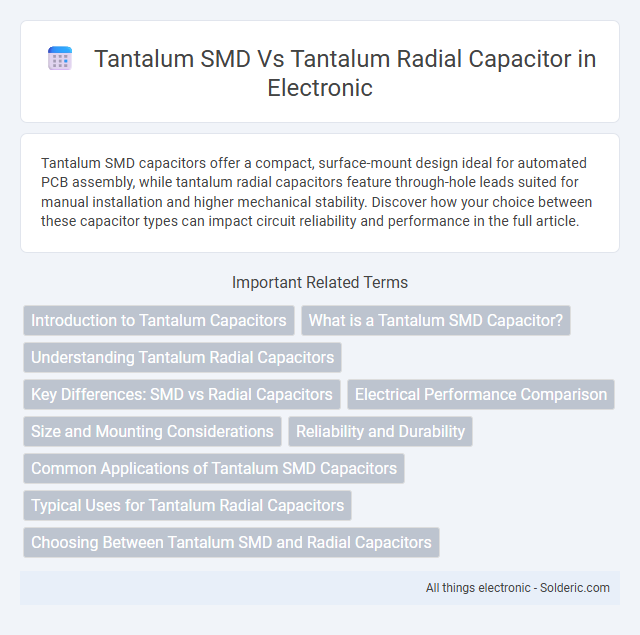Tantalum SMD capacitors offer a compact, surface-mount design ideal for automated PCB assembly, while tantalum radial capacitors feature through-hole leads suited for manual installation and higher mechanical stability. Discover how your choice between these capacitor types can impact circuit reliability and performance in the full article.
Comparison Table
| Feature | Tantalum SMD Capacitor | Tantalum Radial Capacitor |
|---|---|---|
| Mounting Type | Surface Mount Device (SMD) | Through-Hole Radial Leads |
| Size | Compact, low profile | Larger, bulkier |
| Installation | Soldered on PCB surface | Inserted into PCB holes, soldered |
| Applications | High-density circuit boards, portable devices | Power supplies, audio equipment, older designs |
| Electrical Characteristics | Stable capacitance, low ESR, high reliability | Similar capacitance range, generally higher ESR |
| Cost | Typically higher due to packaging and automation | Lower cost, easier manual assembly |
| Thermal Performance | Better heat dissipation with proper PCB design | Good heat tolerance, but larger thermal mass |
| Mechanical Stress | Less mechanical stress from vibrations | More prone to lead damage during handling |
Introduction to Tantalum Capacitors
Tantalum SMD capacitors offer a compact, surface-mount design with excellent stability and low ESR, ideal for high-frequency applications and automated PCB assembly. Tantalum radial capacitors feature a leaded design providing higher capacitance values and robust mechanical strength, commonly used in power supply filtering and energy storage. Both types utilize tantalum oxide dielectric, ensuring reliable performance, long life, and high volumetric efficiency in electronic circuits.
What is a Tantalum SMD Capacitor?
A Tantalum SMD capacitor is a surface-mount device known for its high capacitance-to-volume ratio and stable electrical performance, making it ideal for compact electronic circuits. Unlike tantalum radial capacitors, which have axial leads for through-hole mounting, SMD tantalum capacitors are soldered directly onto the PCB, offering improved assembly efficiency and reduced parasitic inductance. Your choice depends on space constraints and mounting techniques for optimal circuit design.
Understanding Tantalum Radial Capacitors
Tantalum radial capacitors feature a cylindrical shape with axial leads extending from one end, enabling straightforward insertion into through-hole PCB layouts. Unlike tantalum SMD capacitors, which are designed for surface mounting and compact assemblies, radial capacitors provide higher capacitance values with stable performance in power supply filtering and audio applications. Understanding these characteristics helps you select the appropriate tantalum capacitor type for your circuit's electrical and mechanical requirements.
Key Differences: SMD vs Radial Capacitors
Tantalum SMD capacitors offer a compact, low-profile design ideal for automated surface-mount technology, providing higher volumetric efficiency and better suitability for high-frequency applications compared to tantalum radial capacitors. Radial tantalum capacitors feature leads for through-hole mounting, which facilitates manual assembly and increased mechanical stability in environments subject to vibration or mechanical stress. The choice between SMD and radial hinges on PCB layout constraints, assembly methods, and performance requirements in terms of ESR, ripple current, and size.
Electrical Performance Comparison
Tantalum SMD capacitors exhibit lower equivalent series inductance (ESL) and equivalent series resistance (ESR) compared to tantalum radial capacitors, resulting in superior high-frequency performance and reduced noise. The compact surface-mount design enhances thermal dissipation, maintaining capacitance stability under varying temperature conditions. While radial capacitors offer higher capacitance packages, tantalum SMD capacitors provide more consistent electrical performance in compact, automated circuit assemblies.
Size and Mounting Considerations
Tantalum SMD capacitors offer a significantly smaller footprint and lower profile compared to tantalum radial capacitors, making them ideal for compact, high-density circuit designs. Their surface-mount technology allows automated placement on PCB pads, enhancing manufacturing speed and reliability, whereas radial capacitors require through-hole mounting, leading to larger board space usage and more complex assembly processes. Size and mounting constraints make tantalum SMD capacitors preferable for miniaturized electronics, while radial types remain suitable for applications needing higher capacitance and voltage ratings where space is less critical.
Reliability and Durability
Tantalum SMD capacitors offer higher reliability in automated manufacturing processes due to their compact size and consistent performance under thermal cycling. Tantalum radial capacitors, with their robust leads and thicker encapsulation, demonstrate superior durability in harsh mechanical environments and shock resistance. Choosing the right type ensures your circuit's longevity and stability, especially in applications demanding high endurance.
Common Applications of Tantalum SMD Capacitors
Tantalum SMD capacitors are widely used in compact electronic devices such as smartphones, laptops, and wearables due to their small size, high capacitance, and reliability in high-frequency applications. These capacitors excel in power supply filtering, decoupling, and energy storage in tight PCB layouts where space and performance are critical. Your choice of tantalum SMD capacitors ensures enhanced miniaturization and stable operation in high-density circuit designs compared to traditional tantalum radial capacitors.
Typical Uses for Tantalum Radial Capacitors
Tantalum radial capacitors are commonly used in power supply filtering, audio equipment, and aerospace applications due to their high capacitance-to-volume ratio and excellent stability over temperature and frequency. These capacitors provide reliable performance in environments requiring long-term durability and low equivalent series resistance (ESR), making them suited for pulse load handling and decoupling tasks. Their robust construction supports high ripple current capacities, ideal for smoothing voltage fluctuations in automotive and industrial electronics.
Choosing Between Tantalum SMD and Radial Capacitors
Choosing between tantalum SMD and radial capacitors depends on application requirements such as size, mounting method, and performance. Tantalum SMD capacitors offer compactness and suitability for automated PCB assembly, making them ideal for high-density circuit boards and surface-mount technology. Radial tantalum capacitors provide robust reliability and higher capacitance ratings at a lower cost, preferred in through-hole designs requiring durability and ease of manual assembly.
tantalum SMD vs tantalum radial capacitor Infographic

 solderic.com
solderic.com